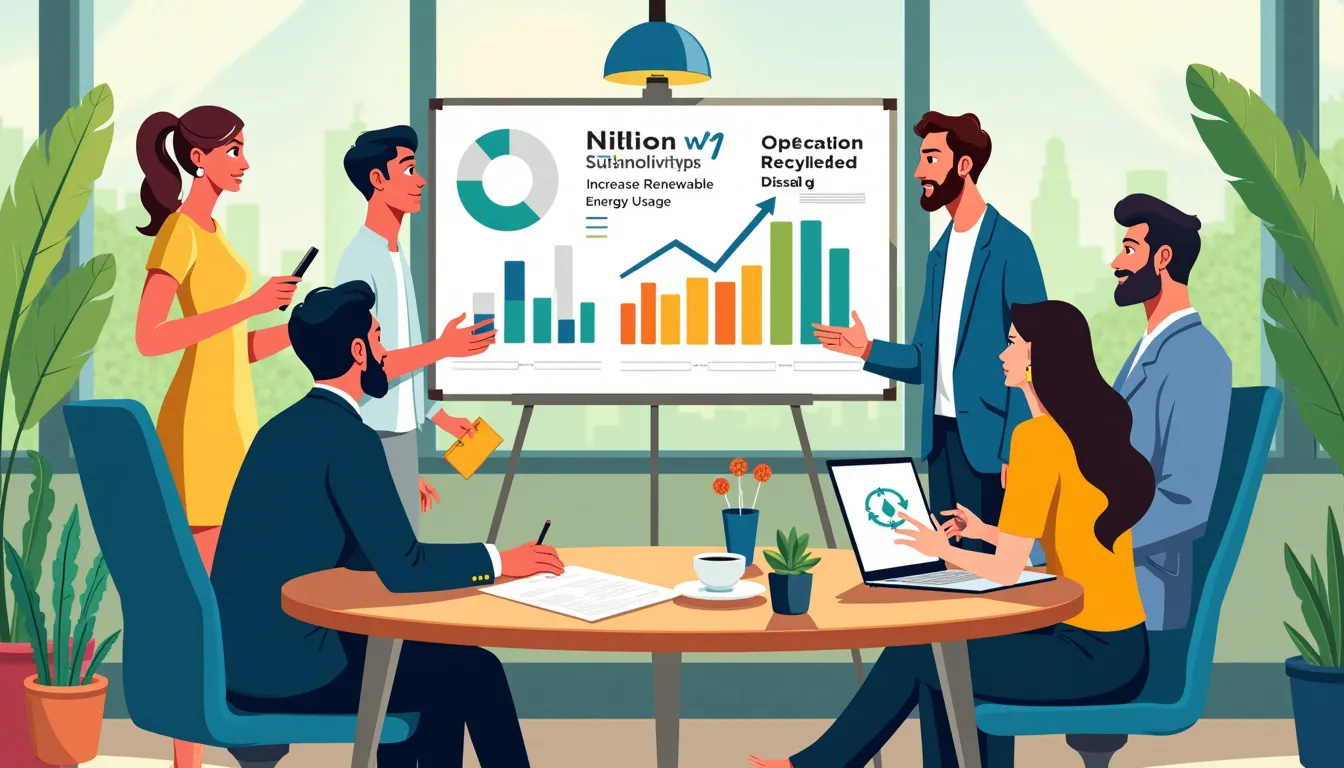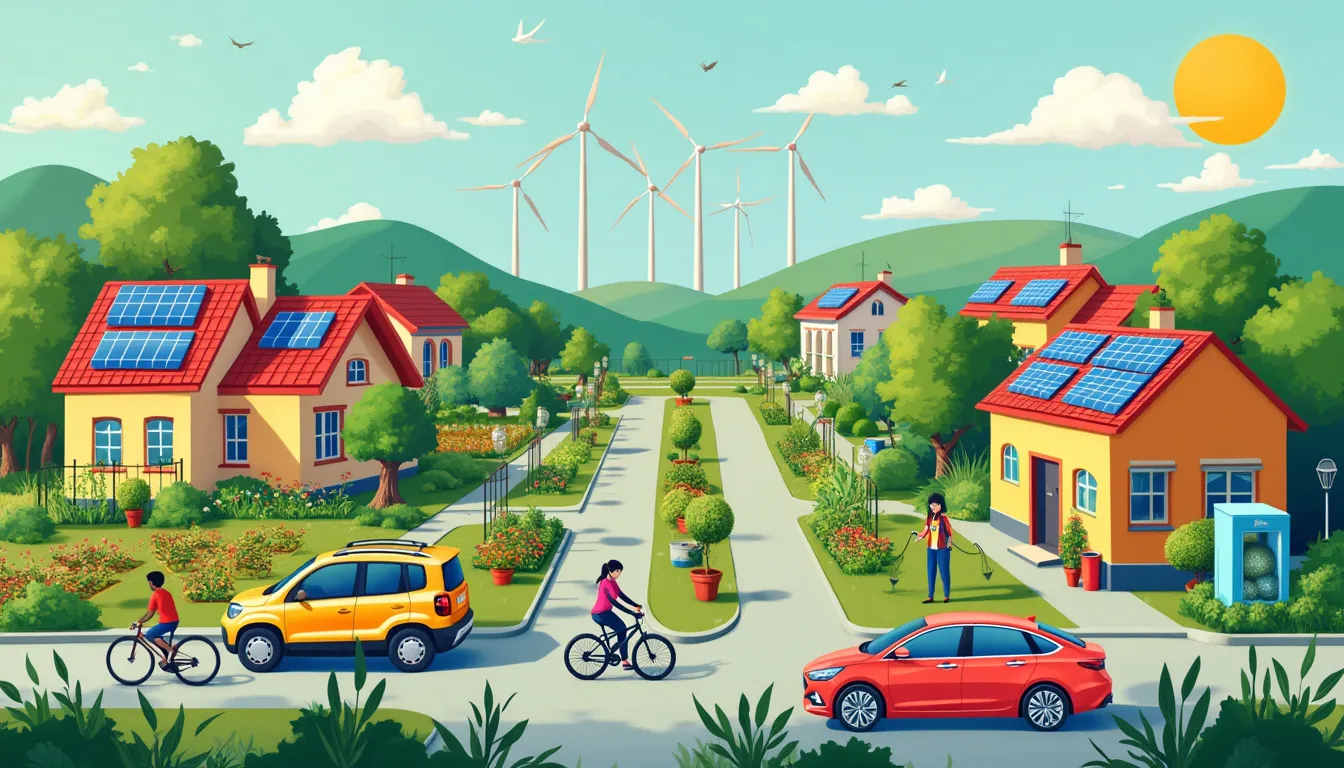In today’s rapidly evolving world, the urgency of addressing environmental challenges has never been clearer. The term sustainability goals is no longer reserved for activists and policy makers; it’s a call to action for individuals and businesses alike. But what exactly does it mean to set and achieve sustainability goals, and why are they so crucial?
At its core, sustainability is about meeting our present needs without compromising the ability of future generations to meet their own. This requires a balanced approach to economic development, environmental health, and social well-being. Sustainability goals serve as a roadmap to ensure this balance, focusing efforts on key areas such as reducing carbon footprints, conserving resources, and fostering community resilience.
Historically, the concept of sustainability has deep roots, from indigenous practices that honored the earth to the more recent environmental movements of the 20th century. Over time, these ideals have evolved into concrete strategies and targets, influenced by pivotal events like the 1992 Rio Earth Summit and the adoption of the United Nations Sustainable Development Goals in 2015. These milestones underscore the global recognition of sustainability’s importance, but they also highlight the collective effort required to drive meaningful change.
Statistics paint a compelling picture of why we need to act. The Intergovernmental Panel on Climate Change (IPCC) reports that human activities have already caused about 1.0°C of global warming above pre-industrial levels. If we continue on our current trajectory, we could see a rise of 1.5°C between 2030 and 2052, leading to severe environmental and societal impacts. Moreover, data from the World Wildlife Fund (WWF) shows that the global population of vertebrate species has declined by an average of 68% since 1970, a clear indicator of ecosystem stress and biodiversity loss.
These figures are daunting, but they also motivate action. By setting and prioritizing sustainability goals, we can drive real progress. Whether you’re a local business owner seeking to reduce waste or a global corporation aiming to lower emissions, clearly defined goals provide direction and measurable benchmarks for success. This guide will walk you through the process of establishing these goals, offering practical strategies and inspiring examples to help you contribute to a more sustainable future. Together, we can turn the tide and achieve ambitious sustainability goals that benefit both people and the planet.
Introduction to Sustainability Goals
Definition and Importance of Sustainability Goals
Sustainability goals are targets set by individuals, communities, and businesses to meet the needs of the present without compromising the ability of future generations to meet their own needs. These goals often encompass a wide array of practices and initiatives aimed at reducing environmental footprints, conserving natural resources, and promoting social and economic well-being.
The importance of sustainability goals cannot be overstated. Achieving these targets is integral not only to the health of our planet but also to the longevity and success of businesses and communities. By focusing on sustainability, organizations can reduce operational costs, enhance their reputation, foster innovation, and ultimately ensure long-term viability.
Historical Context and Evolution
Understanding the historical context of sustainability goals requires looking back at how society’s relationship with the environment has shifted over time. The industrial revolution marked a period of tremendous economic growth, but it also introduced unprecedented environmental challenges. Air and water pollution, deforestation, and the loss of biodiversity began to capture global attention.
By the latter half of the 20th century, a more concentrated effort emerged to address these issues. The publication of Rachel Carson’s Silent Spring in 1962 and the subsequent establishment of Earth Day in 1970 highlighted growing environmental concerns. These movements laid the groundwork for the concept of sustainability as it is recognized today.
The United Nations’ introduction of the Sustainable Development Goals (SDGs) in 2015 was a pivotal moment. These 17 goals provided a comprehensive framework for addressing global challenges such as poverty, inequality, climate change, and environmental degradation. Since then, sustainability goals have evolved from niche initiatives into mainstream objectives for both governments and businesses worldwide.
Key Statistics Highlighting the Need for Sustainability
To emphasize the urgency and necessity of sustainability goals, let’s delve into some key statistics:
1. **Climate Change**: According to NASA, the Earth’s average surface temperature has risen about 1.18 degrees Celsius since the late 19th century, largely due to increased carbon dioxide and other human-made emissions. This warming trend is causing more frequent and severe weather events.
2. **Resource Depletion**: The Global Footprint Network reports that humanity uses the equivalent of 1.7 Earths to produce the resources we consume and absorb our waste. This over-consumption indicates that we are depleting natural resources faster than they can be regenerated.
3. **Waste Generation**: The World Bank estimates that global waste generation is expected to increase by 70% from 2016 levels to 3.40 billion metric tons by 2050 if no significant changes are made.
4. **Biodiversity Loss**: The World Wildlife Fund’s (WWF) Living Planet Index reveals that global populations of mammals, birds, fish, amphibians, and reptiles have declined by an average of 68% between 1970 and 2016, largely due to habitat destruction and climate change.
5. **Economic Costs**: A report by the Global Commission on the Economy and Climate finds that bold climate action could deliver at least $26 trillion in economic benefits by 2030 compared to business as usual. This proves that sustainable practices can create economic value.
These statistics underscore the critical need for concerted efforts to achieve sustainability goals. They highlight the interconnected nature of environmental, social, and economic systems and the profound impact that unsustainable practices have on our world.
By setting ambitious yet achievable sustainability goals, individuals and businesses can contribute to reversing these destructive trends and pave the way for a more resilient future. The journey towards sustainability is not just a moral imperative; it’s a practical necessity for ensuring a healthy planet and prosperous societies for generations to come.

Setting and Prioritizing Sustainability Goals
Steps to Establish Clear and Attainable Goals
When it comes to sustainability, one of the most daunting challenges can be where to start. Setting clear and attainable sustainability goals is crucial for both individuals and businesses aiming to make meaningful changes. The first step is understanding the specific environmental, social, or economic areas you want to impact. This can involve evaluating your current practices and identifying aspects that require the most significant improvement.
Begin with a thorough assessment or audit of your current environmental impact. For businesses, this might mean looking at energy consumption, waste generation, and resource use. For individuals, it could be examining your carbon footprint, water use, and waste habits. Once you have a comprehensive understanding of where you stand, you can begin to outline your objectives.
For example, a company might discover that a significant portion of its waste comes from single-use packaging materials. A practical goal could then be to reduce single-use packaging by 50% within a year. For an individual, this goal might translate into a commitment to use reusable shopping bags and containers to cut down on plastic waste.
Tools and Frameworks for Goal Setting (e.g., SMART goals)
Establishing sustainable goals can be made more accessible through the use of well-defined frameworks and tools. One of the most effective methods is the SMART criteria, which ensures that goals are Specific, Measurable, Achievable, Relevant, and Time-bound. This framework offers a clear path and milestones while ensuring that goals are realistic and attainable.
– **Specific:** Clearly define your goals. Instead of saying reduce waste, specify reduce plastic waste by 30%.
– **Measurable:** Ensure you have a method to track progress. This could involve metrics like waste weight, energy usage, or recycling rates.
– **Achievable:** Set realistic targets. Cut down energy usage by 10% might be more realistic than 50% in the short term.
– **Relevant:** The goals should align with broader objectives. Reducing carbon footprint is relevant to global efforts against climate change.
– **Time-bound:** Assign deadlines to your goals. Aim to achieve specific goals within six months or a year to maintain momentum.
Another useful tool is the Triple Bottom Line (TBL) framework, which focuses on People, Planet, and Profit. This framework evaluates sustainability goals based on their social, environmental, and economic impacts, ensuring a holistic approach.
Prioritizing Goals Based on Impact and Feasibility
Not all sustainability goals are created equal. Some will have a more significant impact on your overall sustainability than others. Therefore, it’s crucial to prioritize these goals based on their potential impact and the feasibility of achieving them.
Start by identifying the low-hanging fruit – goals that are relatively easy to achieve but can yield substantial benefits. For instance, switching to energy-efficient lighting is a simple change that can significantly reduce energy consumption and costs. Similarly, incorporating recycling programs or replacing single-use items with reusable alternatives can be straightforward and impactful.
Next, consider larger, more challenging goals that may require more resources but promise significant benefits. These might include transitioning to renewable energy sources, implementing comprehensive waste reduction programs, or redesigning products to be more sustainable. Use impact assessments to evaluate the potential benefits and drawbacks of each goal. This can involve quantifying CO2 emissions reductions, resource savings, and cost implications.
For businesses, aligning sustainability goals with corporate social responsibility (CSR) strategies can enhance brand reputation, improve stakeholder relationships, and attract eco-conscious consumers. A company could prioritize sourcing materials from sustainable suppliers, reducing carbon emissions, or investing in community development programs.
In personal life, you might prioritize goals like reducing water usage by installing low-flow fixtures or cutting down on meat consumption. Engaging in local sustainability initiatives or community clean-up projects can also broaden your impact while fostering a sense of community involvement.
Remember that setting and prioritizing goals is not a one-time activity. It’s essential to periodically revisit and adjust your goals based on progress and changing circumstances. Continuously educating yourself about emerging sustainability trends and innovative solutions can help in refining your objectives and strategies.
In summary, the journey to sustainability begins with setting clear, attainable goals, utilizing reliable frameworks like SMART and TBL, and prioritizing efforts based on their impact and feasibility. By taking these steps, you are not only contributing to a healthier planet but also fostering a more sustainable lifestyle or business practice.

Strategies for Achieving Sustainability Goals
Implementing Sustainable Practices
Adopting sustainable practices is the cornerstone of achieving sustainability goals. These practices span across various domains such as energy usage, waste management, and resource efficiency. Each practice contributes significantly to reducing environmental impact and promoting sustainable development.
Renewable Energy: Transitioning to renewable energy sources like solar, wind, and hydro power is a powerful strategy. According to the International Renewable Energy Agency (IRENA), renewables could supply 90% of the necessary power by 2050, significantly cutting down carbon emissions. By integrating renewable energy systems, businesses and individuals can not only reduce their carbon footprint but also potentially lower energy costs in the long run.
Waste Reduction: Effective waste management involves reducing, reusing, and recycling materials. The U.S. Environmental Protection Agency (EPA) reports that recycling 1 ton of paper saves 17 mature trees and 7,000 gallons of water. Implementing comprehensive recycling programs and encouraging the reuse of materials can help businesses turn waste into a resource, thus minimizing landfill use and its associated environmental problems.
Energy Efficiency: Enhancing energy efficiency can be as simple as upgrading lighting systems to LEDs or as complex as retrofitting entire buildings to meet higher energy performance standards. According to the American Council for an Energy-Efficient Economy (ACEEE), many energy efficiency measures can reduce energy usage by 20-30%, leading not only to cost savings but also a significant reduction in greenhouse gas emissions.
Engaging Stakeholders and Building a Sustainability Culture
Stakeholder engagement is crucial for the successful implementation of sustainability goals. It’s important to include employees, customers, suppliers, and the broader community in your sustainability initiatives.
Employee Engagement: Encourage employees to participate in sustainability efforts through training programs and incentive schemes. Companies like Patagonia have successfully engaged their workforce by embedding sustainability into their corporate culture, providing educational resources, and rewarding sustainable practices. Employees who are passionate and informed about sustainability are more likely to contribute innovative ideas and help drive the company’s objectives.
Customer Involvement: Transparency is key in involving customers. Clear communication about your sustainability goals and progress can build trust and customer loyalty. Brands such as Unilever have seen positive results by sharing their sustainability initiatives openly and encouraging customers to join the cause, for instance, by participating in product recycling programs or supporting fair trade products.
Community and Supplier Engagement: Building strong relationships with suppliers and the community can amplify sustainability efforts. Work with suppliers to ensure they adhere to ethical and environmental standards. For example, IKEA works closely with suppliers to source sustainable materials and reduce environmental impact. Engage with the local community through programs that support environmental conservation and social welfare projects.
Monitoring Progress and Adapting Strategies
Regular monitoring and evaluation are essential to ensure your sustainability goals are on track. This process involves setting benchmarks, tracking performance, and being prepared to adapt strategies as needed.
Set Clear Benchmarks: Use specific metrics to measure progress. Organizations like the Global Reporting Initiative (GRI) provide frameworks for tracking sustainability performance. These standards help businesses clearly communicate their progress on various aspects like emissions, water usage, and social impact.
Regular Reporting: Frequent reporting keeps all stakeholders informed and engaged. Annual sustainability reports can showcase achievements, highlight areas for improvement, and reinforce the organization’s commitment to its sustainability goals. Many companies, such as Starbucks, publish extensive annual reports detailing their progress on sustainability targets.
Adapt and Innovate: The path to sustainability is rarely linear. Be prepared to reassess and adjust your strategies based on performance data and changing circumstances. For instance, if a particular waste reduction strategy isn’t yielding the expected results, explore alternative methods or technologies that could be more effective. Companies like Tesla are constantly innovating and adapting their technologies to improve environmental performance and meet their ambitious sustainability goals.
By implementing sustainable practices, engaging all stakeholders, and consistently monitoring and adapting strategies, both individuals and businesses can make substantial progress toward their sustainability goals. These efforts not only contribute to environmental preservation but also create economic and social value, ultimately fostering a sustainable future for all.

Case Studies and Success Stories
Examples of Organizations that Achieved Their Sustainability Goals
When it comes to sustainability goals, real-world examples can offer not just inspiration but practical insights into what works. Look at Patagonia, for instance. This outdoor apparel company has been a pioneer in sustainability long before it became a corporate buzzword. Patagonia’s mission to build the best product, cause no unnecessary harm, use business to inspire and implement solutions to the environmental crisis is more than just a tagline. The company has systematically aimed to reduce its environmental footprint by implementing stringent supplier assessment protocols and using recycled materials. Their Worn Wear program encourages customers to repair and reuse products, significantly reducing waste.
Another compelling example is Unilever. The global consumer goods company set ambitious sustainability goals through its Unilever Sustainable Living Plan, aiming to halve the environmental footprint of its products by 2030. As of recent reports, Unilever has achieved a reduction in CO2 emissions, waste, and water usage across its supply chain. Their success stems from embedding sustainability into the core of their business strategy and engaging all stakeholders, including suppliers and consumers, to work towards these goals.
Lessons Learned and Best Practices
From these organizations, several valuable lessons and best practices can be gleaned:
1. Embed Sustainability into Core Values
Companies like Patagonia and Unilever demonstrate that sustainability should be interwoven into the company’s core values and business strategy. When sustainability aligns with the company mission, it ceases to be a side project and becomes a driving force behind every decision.
2. Engage Stakeholders at All Levels
Engaging stakeholders—employees, suppliers, customers, and communities—is crucial. Unilever’s success, for instance, owes much to its comprehensive approach to stakeholder engagement. They’ve educated consumers on sustainability, provided training to farmers and suppliers, and even required a percentage of recycled plastic in product packaging.
3. Measure and Adapt
Track progress meticulously. The importance of data cannot be overstated. Both Patagonia and Unilever constantly monitor their sustainability metrics and adapt their strategies based on what’s working and what isn’t. Technologies like IoT (Internet of Things) and big data analytics can be invaluable in this regard, offering real-time insights and enabling agile adjustments.
4. Innovate Continuously
Don’t just follow existing paths; push boundaries. Innovation is key to achieving—and surpassing—sustainability goals. For instance, Patagonia is known for its research into sustainable materials. Unilever has made strides in developing biodegradable cleaning agents. Regularly invest in R&D and be unafraid to pivot when new, more sustainable technologies and methods become available.
Future Trends and Innovations in Sustainability
The future of sustainability is as exciting as it is crucial. Several trends and innovations are shaping the next steps for businesses committed to sustainable practices.
1. Circular Economy
The concept of a circular economy—where waste is minimized, and resources are reused and recycled—is gaining traction. Companies are realizing that linear supply chains are unsustainable. Instead, they are designing products for longevity and recyclability. For example, tech giant Apple has launched initiatives to recover and reuse rare materials from old devices.
2. Sustainable Supply Chains
Blockchain technology is emerging as a game-changer for sustainable supply chains. It offers transparency that ensures ethical practices are maintained from production to delivery. Walmart has been piloting blockchain to trace food contamination sources, but this technology can be leveraged to verify the sustainability of entire supply chains.
3. Renewable Energy Integration
Successful integration of renewable energy sources such as wind, solar, and hydro into business operations is becoming a standard rather than an exception. Companies like Google and Ikea have committed to using 100% renewable energy. This shift not only helps to mitigate climate change but also can offer long-term cost savings.
4. AI and Machine Learning
Artificial Intelligence (AI) and machine learning are beginning to play significant roles in achieving sustainability goals. These technologies can optimize energy use, reduce waste, and improve resource efficiency. For instance, AI algorithms can predict energy needs, thereby reducing consumption and reliance on non-renewable resources.
5. Biodegradable and Eco-friendly Products
The demand for biodegradable and eco-friendly products is skyrocketing. Materials like biodegradable plastics and plant-based alternatives are not only reducing waste but also attracting eco-conscious consumers. Companies that can innovate in this space are likely to see both environmental and economic benefits.
Conclusion
The journey towards achieving ambitious sustainability goals is complex but far from impossible. By learning from organizations that have successfully navigated this path and staying abreast of future trends and innovations, businesses can make meaningful contributions to a sustainable future. Remember, every small step counts, whether it’s in reducing waste, innovating products, or engaging stakeholders. The key is to start and keep moving forward.
As we conclude our comprehensive guide on achieving ambitious sustainability goals, it’s clear that the journey towards a more sustainable future requires both commitment and strategic action. The urgency to adopt sustainable practices cannot be overstated, as evidenced by key statistics showing the accelerating impact of environmental degradation.
Setting and prioritizing sustainability goals is the foundational step. Utilizing structured frameworks like SMART goals helps ensure that targets are clear, measurable, and attainable. By identifying actions that offer the greatest impact and feasibility, individuals and businesses can focus their efforts more effectively.
Practical strategies for achieving these goals are diverse and context-dependent. Embracing renewable energy, reducing waste, and fostering a culture of sustainability within your organization are crucial steps. The inclusion of stakeholders in sustainability initiatives creates a sense of shared responsibility and encourages collective action. Continuous monitoring and adaptability ensure that strategies remain aligned with evolving circumstances and technologies.
Examining case studies and success stories provides valuable insights and inspiration. These real-world examples illustrate that achieving ambitious sustainability goals is possible and beneficial. They also highlight innovative approaches and emerging trends that can guide future efforts.
In essence, the path to sustainability is a collaborative venture that demands dedication at both individual and organizational levels. To make a tangible difference, start by integrating sustainable practices into your daily routine. For businesses, adopting a comprehensive sustainability strategy not only contributes to environmental preservation but also adds long-term value.
By taking actionable steps today, you contribute to a healthier planet for future generations. Whether through small daily changes or large-scale organizational shifts, every effort counts. Let’s commit to pursuing our sustainability goals with renewed vigor and determination, knowing that a sustainable future is both our responsibility and our opportunity.
Support Us: Check out our recommended products on Amazon.

